 |
 |
 |
| |
IMPACT OF ANTIRETROVIRAL THERAPY INITIATION ON EPIGENETIC AGING AND TELOMERE LENGTH
|
| |
| |
CROI 2020
Reported by Jules Levin
Andres Esteban-Cantos1, Javier Rodríguez-Centeno1, Pilar Barruz1, Francisco Gaya1, Julian Nevado1, Belen Alejos2, Natalia Stella-Ascariz1, Rocio Montejano1, Jose I. Bernardino1, Eric Florence3, Lars Mathiesen4, Rosa de Miguel1, Francisco Arnalich1, Fiona Mulcahy5, Denes Banhegy1, Cedrick Wallet6, François Raffi7, Berta Rodes1, Jose R. Arribas1
1Hospital La Paz Institute for Health Research, Madrid, Spain, 2Institute of Health Carlos III, Madrid, Spain, 3Institute of Tropical Medicine, Antwerp, Belgium, 4Copenhagen University Hospital, Copenhagen, Denmark, 5St. James's Hospital, Dublin, Ireland, 6University of Bordeaux, INSERM, Bordeaux Population Health Research Center, CHU de Bordeaux, Bordeaux, France, 7CHU de Nantes, Nantes, France
from Jules: these findings appears to me to be similar to the Julia Marcus/ Kaiser Life Expectancy study that found 9 years shorter life expectancy in HIV+. But for those starting ART in that study there was no difference in life expectancy between HIV+ and HIV-negative: In one large US healthcare system, HIV-positive people who started antiretroviral therapy (ART) at a high CD4 count now live as long as HIV-negative people [1]. But the HIV cohort lives "substantially fewer healthy years [16 year were comorbidity-free years than people without HIV] than people without HIV," regardless of early ART. And this study looks at comorbidyt free years for specific comorbidities- liver, kidney, diabetes, cancer, CVD.
CROI: Increased overall life expectancy but not comorbidity-free years for people with HIV - (03/27/20)
Age advancement (EA minus chronological age) significantly improved after ART initiation (BL: 8.3 vs W96: 6.5 years, p=0.007).
ABSTRACT: EA stabilized and EAA slowed in the majority of patients after starting ART. However, an age advancement of 6.5 years persisted after the first two years of successful ART. The reversal of epigenetic aging and the increase in blood TL caused by ART initiation are likely driven by changes in T cell subtypes toward less differentiated phenotypes.
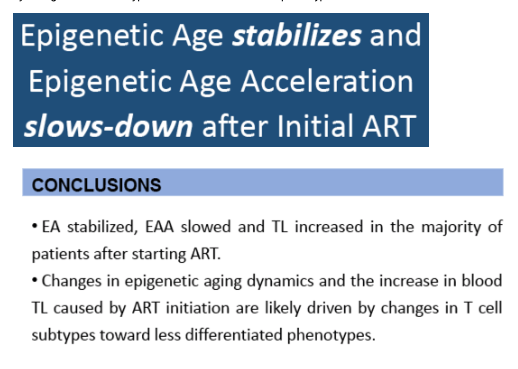
program abstract
We analyzed 114 randomly selected participants in the NEAT001/ANRS143 clinical trial before and 96 weeks (W96) after initial ART introduction. Whole blood DNA methylation profiles were assayed via Illumina Infinium MethylationEPIC BeadChips. Data were preprocessed using Noob normalization. The EA and estimated abundance of leukocyte subsets were obtained from the advanced analysis for blood tissue using the Horvath´s DNA methylation Age Calculator. We estimated three EAA measures: universal (AgeAccel), extrinsic (EEAA) and intrinsic (IEAA). We measured telomere length (TL) with multiplex qPCR.
At baseline (BL), male: 88%, mean chronological age: 39.2 years, Caucasian: 80%, HIV-1 RNA: 4.7 log10 c/ml, and mean CD4+ and CD8+ (flow cytometry): 311 and 954 cells/l.
At W96, 96% had HIV-RNA <50 c/ml and mean CD4+ and CD8+ were 564 and 845 cells/l.
At BL, EA positively correlated with chronological age (rho: 0.891, p<0.001) while TL correlated negatively (rho: -0.490; p<0.001).
Mean EA at BL and W96 was 47.5 and 47.6 years respectively.
Age advancement (EA minus chronological age) significantly improved after ART initiation (BL: 8.3 vs W96: 6.5 years, p=0.007). Compared with BL, two measures of mean EAA slowed at W96 (AgeAccel: -1.49 years, p=0.011; EEAA: -4.02 years, p<0.001), while IEAA did not change (0.03 years, ns). EAA decreased in 71.05% (AgeAccel) and 78.07% (EEAA) of participants.
At W96, EA correlated negatively with CD4+/CD8+ ratio by flow cytometry, estimated CD4+, nave CD4+ and nave CD8+, and positively with estimated CD8+CD28-CD45RA- T cells and NKs. Mean TL change at W96 was 0.034 (T/S). At W96 TL correlated positively with CD4+/CD8+ ratio by flow cytometry, estimated abundance of total CD4+, nave CD4+ and nave CD8+ and negatively with estimated abundance of CD8+CD28-CD45RA- and NKs (Table).
EA stabilized and EAA slowed in the majority of patients after starting ART. However, an age advancement of 6.5 years persisted after the first two years of successful ART. The reversal of epigenetic aging and the increase in blood TL caused by ART initiation are likely driven by changes in T cell subtypes toward less differentiated phenotypes.
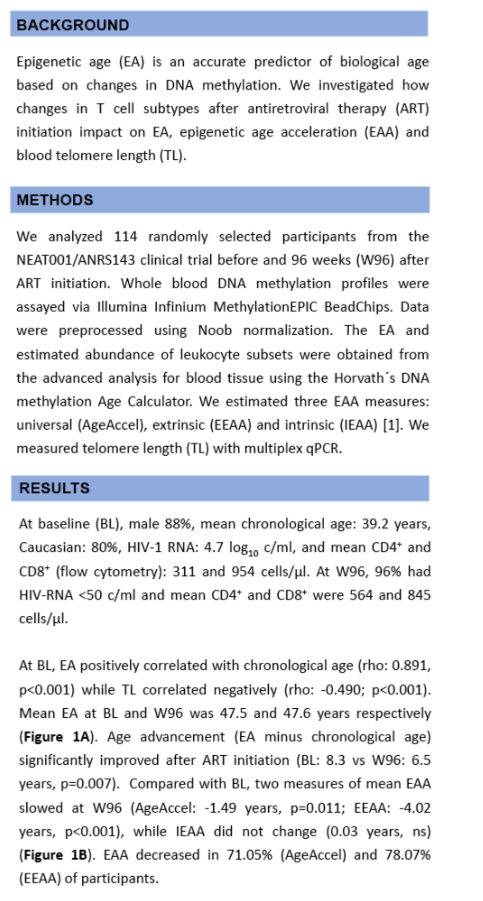
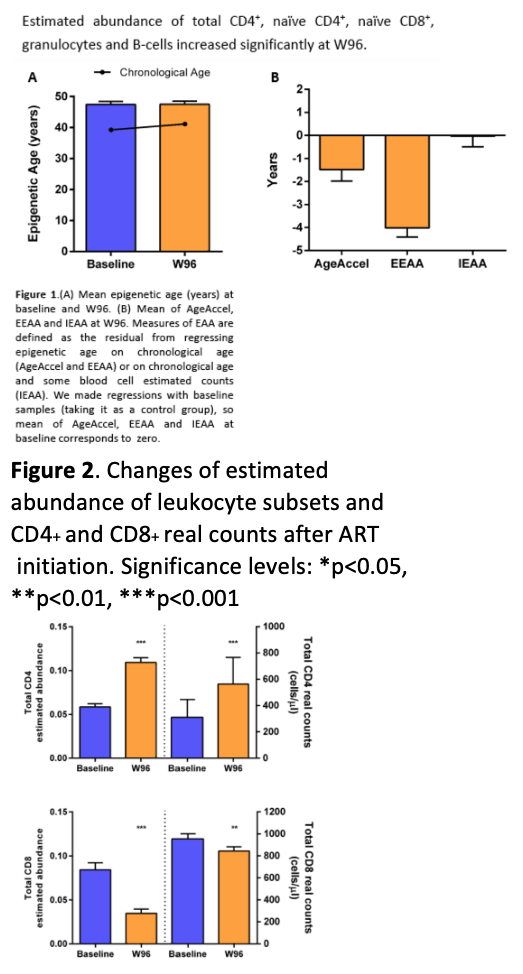
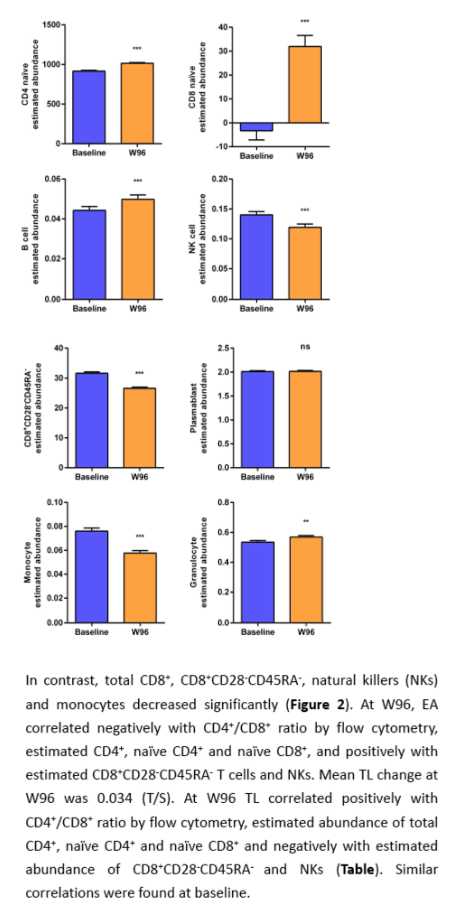
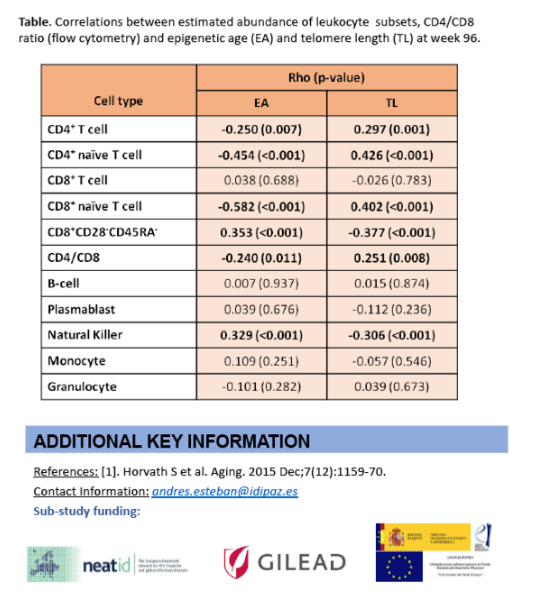
|
| |
|
 |
 |
|
|